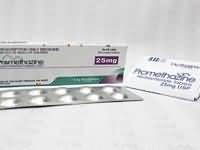CLINICAL USE
Antipsychotic for agitation and restlessness
DOSE IN NORMAL RENAL FUNCTION
Psychomotor agitation: 100–200 mg 4 times a dayAgitation and restlessness in elderly: 25–50 mg 4 times a day
PHARMACOKINETICS
As for chlorpromazine
DOSE IN RENAL IMPAIRMENT
GFR (mL/MIN)
DOSE IN PATIENTS UNDERGOING RENAL REPLACEMENT THERAPIES
IMPORTANT DRUG INTERACTIONS
Potentially hazardous interactions with other drugs
ADMINISTRATION
Reconstition
–
Route
Oral
Rate of Administration
–
Comments
–

